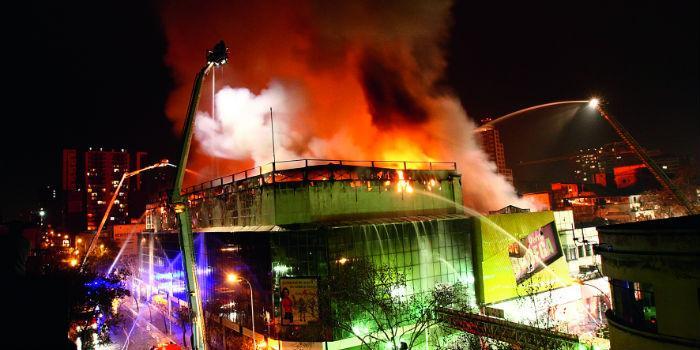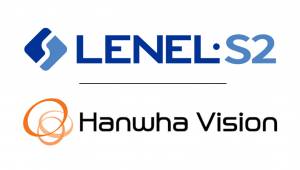 A fire in a cellar with shelves is the perfect fire. A large amount of fuels – boxes, plastics, wooden pallets – is combined with a geometry that helps the rapid development of the fire.
A fire in a cellar with shelves is the perfect fire. A large amount of fuels – boxes, plastics, wooden pallets – is combined with a geometry that helps the rapid development of the fire.
By Jaime A. Moncada*
To make matters worse, the shelves, as well as the roof of the cellar, are not designed to withstand a free-growing fire, so they collapse quickly if there is no early control of the fire.
This obviously makes an indoor attack, either by a brigade or by firefighters, very dangerous. Thus the warehouse stores metal spare parts, these are quite possibly individually wrapped in plastic and packed in a cardboard box, which in turn are packed in another box that includes 12 boxes, and in another box that includes 12 dozen.
These boxes are in turn packed in a pallet with 27 boxes of 12 dozen, which has been encapsulated1. This whole arrangement is consequently very combustible.
Devastating Fires: Although warehouses with storage have always been present in Latin America, it has not been until recent times that greater attention has been paid to their protection, particularly now that not only the number of this type of facilities has increased, but its area and height. I remember several years ago having visited the fire of a storage warehouse on shelves of 15,000 m2 of built area in Cali, Colombia (see attached photo).
This warehouse had been efficiently managed, had been excellently maintained and its fire protection, according to its operator, was the best they had found on the market: smoke detection through light beam detectors and water hoses. Despite the effective alarm of the detection system and the immediate response of the fire department, the fire was a total loss valued at the time at US $45 million. The blame for this total loss was not because the detection system was not good, nor because the firefighters did not act properly, but rather because of the lack of automatic sprinklers. On that visit I heard something I had heard many times before: "but engineer, we never think about sprinklers since here we store only finished product!"
In recent years I have been working in the Colon Free Zone at the mouth of the Caribbean Sea of the Panama Canal, where there is already the largest set of wineries in Latin America. There, in recent times, three multimillion-dollar fires have occurred. In my visits to these claims I have found practically the same thing: total losses and lack of automatic sprinklers. There I have visited, for example, a completely new shelf cellar of three levels, each of them of 140,000 m2 of built area and connected to each other by immense openings, protected only with poorly installed smoke detectors and fire water hoses.
I heard the same thing as in Cali, where automatic sprinklers were not thought of because there was finished product, this being the only known option to obtain adequate fire protection. It should be clear that a declared fire in a storage warehouse, which is not protected by an automatic sprinkler system, usually results in a total loss.
I must also mention the fire at the Iron Mountain winery in Barracas, Buenos Aires Province, Argentina. In this fire, which occurred on February 5, 2014, 10 firefighters died. The cellar was not very large, only 2500 m2 of built area, but the ferocity of the fire was enough to quickly collapse the roof, and minutes later the exterior walls, which unfortunately collapsed on the firefighters. Although the investigation of this fire has not yet been made public, one theory is that the water storage system was being maintained at the time of the fire, and consequently the sprinklers had no water.
How Warehouses Are Protected - Due to the risk of fire in a warehouse, NFPA requires that any type of storage buildings, where the area exceeds 1115 m2, must be protected by automatic sprinklers designed according to NFPA 13 (NFPA 1-2015, art. 13.3.2.27.2). If this storage is on shelves, then sprinklers are required if the storage area exceeds 232 m2 (NFPA 1-2015, Art. 13.3.2.27.1). NFPA does not require the installation of smoke detection systems in storage areas and leaves the requirement to install indoor hoses to the discretion of the competent authority.
NFPA Standard – The best-known standard for the design of automatic sprinklers, the main fire protection system in storage facilities, is NFPA 13, Sprinkler Systems Installation Standard. Approximately 25% of the normative text of this standard has to do specifically with storage. Fortunately for the designer and installer of these systems, there are new sources of information on this topic. The National Fire Sprinkler Association (NFSA) has published a Handbook for "Fire Protection of Storage Uses," written by Ken Isman, who is now a professor of protective engineering at the University of Maryland and who is a member of several NFPA committees, including the committee on sprinkler system installation criteria.
This Manual, based on the 2002 edition of NFPA 13, is an excellent text for understanding how to protect a warehouse with automatic sprinklers. Although it does not include the latest information on this topic, it is an excellent document that explains, through practical exercises, the design methodology of automatic sprinklers protecting storage warehouses.
The problem of fire protection in storage warehouses began to be evaluated, using automatic sprinklers, for the first time in 1947, when real tests began in a fire laboratory of Factory Mutual (FM). Underwriters Laboratories (UL) does the same in a slightly larger laboratory starting in 1954. As a result of the conclusions of these tests, in 1965, the NFPA 231 standard, Automatic Sprinkler Standard in Storage2 was born and it is the first time that the fire protection criteria are based on real evidence. In 1967 they began to evaluate fires on shelves in a laboratory of 4645 m2 of built area of FM.
From that date to here a lot of progress has been made, going through sprinklers with a larger drop of water, so that the water can pass through the plume of smoke and the flames of the fire and reach its base, to the sprinkler type ESFR (Rapid Response Early Suppression), where it is sought that the sprinkler operates much earlier throwing important volumes of water with great speed so that it can be controlled in fire more opportunely.
Today, NFPA 13 includes everything from criteria for general storage, to the protection of all types of goods, plastics or rubbers in piles or on shelves, to the storage of paper rolls, tires and other types of risks that pose a great challenge at the time of their control and extinction against fires. The existing options on the market are increasingly wide and the identification of the most suitable sprayer has become a soup of acronyms and acronyms, which present several options to the designer such as the aforementioned ESFR, but including VELO sprinklers (Very Extra Large Hole), LD (Fat Drop), CMSA (Specific Use Control Mode), CMDA (Density by Area Control Mode), XLO/ELO (Extra Large Hole), EC (Extended Coverage), IS (Intermediate Sprinklers) and many more. The hole of the sprinkler ranges from K Factors of 5.6 to 25.2, which also have minimum and different requirements of residual pressure in the sprinkler. All this leads to the protection of a warehouse must be expertly evaluated by a fire protection engineer who weighs all these options in order to find the system with the highest cost benefit and that presents flexibility in the type of materials that can be stored.
FM Global Regulations - FM Global (FM) published in Spanish in 2010 the Technical Data Sheet for the Prevention of Accidents 2-0, which establishes the Guidelines for the Installation of Automatic Sprinklers. This data sheet should also be used with Data Sheet 8-9, on Storage, establishes recommendations for all types of storage of Class 1 to 4 amenities and plastics. These data sheets are used by FM policyholders and by reference by many insured facilities as highly protected irrigation (HPR). FM Global recommends protection criteria that in many cases are different from the recommendations established by NFPA 13.
Cepreven in Spain recently published a study entitled "Automatic Sprinkler Installations, Comparative Design Solutions: UNE-EN/NFPA/FM Global, 2013 Edition". This document, although it includes the European regulations on sprinklers, of little use in our region, is the first authoritative study that I know of where NFPA 13 and the design criteria of FM Global are compared. This document is intended to be a guide that allows to know the main criteria or approximations of each of these standards to certain fire protection challenges. In a clear and orderly way, it presents how each of these design standards provides solutions to several practical cases, mainly industrial and storage. Of the nine case studies analyzed, there are six that offer a direct comparison between NFPA 13 and fm fact sheets.
Although, especially with NFPA 13, there is often more than one way to protect a structure, it does not seem that neither FM nor NFPA can argue that their standards offer, for each case, more convenient solutions for the end user, from an economic point of view. According to the Cepreven study, in half of the cases NFPA requires lower flows and water reserve, while in the other half FM is lower. The flows and size of the water reserve can be determining factors in the cost of the system.
This column is not intended to give my opinion on whether NFPA 13 or FM 8-9 is better, or that it is right or wrong, but rather to offer a little more clarity on this topic. From my point of view, it must be assumed that both documents offer an adequate level of fire protection. But the first thing we need to understand is that the NFPA regulation follows an open consensus process, where anyone, including a representative of FM Global, can propose changes to the standards.
FM Global, on the other hand, is a mutual that offers property insurance, commercial and industrial clients around the world, and is recognized as a leader in the insurance industry. FM has followed since its inception the philosophy of designing engineering-based loss control solutions. Its research laboratory in West Glocester, Rhode Island is a recognized leader in the development of advanced fire protection techniques. But at the end of the day, as Russ Fleming, president of the National Fire Sprinkler Association (NFSA), and who chaired the group that evaluated the new FM data sheets for the NFPA 13 Technical Committee, wrote, "we must recognize that FM data sheets have been developed to meet the special needs of an insurer and its policyholders and that they are not consensus standards."3
What should be very clear to all those who evaluate the use of one standard or another, is that the sprinkler system must be designed and installed according to only one of the two standards. You should not choose the items that best suit FM or NFPA13. We must also find out who is asking for the protection of the installation. If you are an FM customer or if the building is going to be rented or sold to a company insured by FM, then it is obvious that the FM technical sheets are what they are worth. Otherwise, unless there are constructive constraints that do not allow compliance with NFPA 13, in my opinion the most obvious option is to protect according to NFPA 13. Define which standard to use based on the cost of the system should be evaluated as the last alternative, with great care and with the approval of the end customer.
1. Packaging method consisting of a plastic film that fully encloses the sides and top of a load on a stowage.
2. This standard and a dozen other standards that had fire protection criteria, are consolidated into a single standard, NFPA 13, a standard that previously did not include storage protection criteria.
3. Report of Task Group to Evaluate FM Data Sprinkler Sheets, February 8, 2011, by Russ Fleming, Chair to NFPA Technical Correlating Committee on Automatic Sprinklers.
*Jaime A. Moncada, PE is a director of International Fire Safety Consulting (IFSC), a fire protection engineering consulting firm based in Washington, DC. and with offices in Latin America. He is a fire protection engineer graduated from the University of Maryland, co-editor of the NFPA Fire Protection Handbook, Vice President of the Society of Fire Protection Engineers (SFPE) and directs NFPA professional development programs in Latin America. Moncada's email address is [email protected].

























Leave your comment